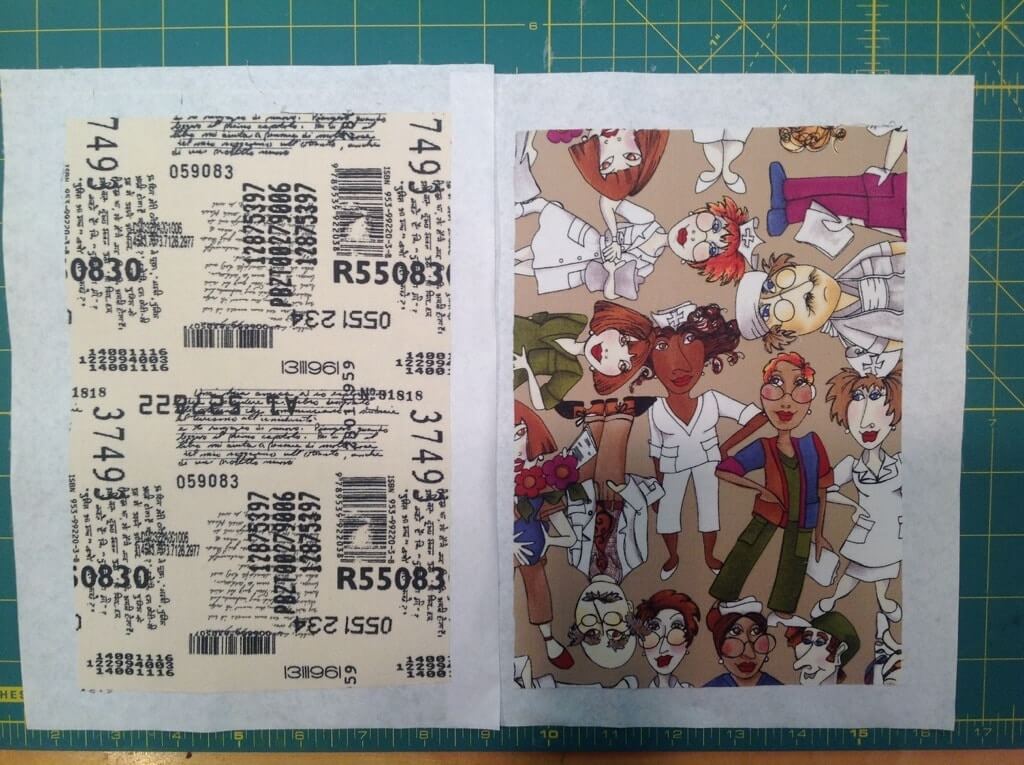Making Your Own Bookcloth
One of the reasons I haven’t taken up quilting is because of the size of the fabric stash I’ve seen in quilters’ closets. I’m creating a smaller version of The Stash using fat quarters. I learned to make my own book cloth using a method from a Tim Ely workshop. He uses bond paper (thin and strong), wheat paste (I use 1 TBS precooked wheat starch with 4.5 TBS distilled water) and fabric. This method is so easy, so neat, requires no PVA, no crumpled paper support, and the paste permeates the fabric to provide some protection. Since the wheat starch is already cooked, this can be done on the spur of the moment and you can make as small a batch as needed (Just keep the 1:4.5 ratio)
 I have two people and two books in mind for this book cloth. Let’s see what kind of book structures I devise!
I have two people and two books in mind for this book cloth. Let’s see what kind of book structures I devise!


Heh heh heh! Fabric stashes! I don’t quilt, but still have too much. Which I’ve been using to make bookcloth with as well (seems to be a theme emerging). Wonderful! It is indeed addictive to make custom bookcloth. At the moment, I’ve been doing the cheaters’ method with fusible web instead of being proper and traditional like you. I’ve been using interleaving paper from Daniel Smith, which is pretty much the same as bond (and I concur, it works very well). Great post–makes me want to go make more bookcloth!
I don’t remember a fabric stash in your studio! All the more reason for another visit. I have a number of quilting friends and their Stash has taken over their closets. Hmmmm. Maybe that wouldn’t be so bad. My first book cloth was made in a workshop at the San Francisco Center for the Book. Thin Japanese paper was used and PVA was rolled over the paper and allowed to dry enough to be tacky. The cloth was then put on top and ironed to the paper. I had a number of problems with this: paper rolled up or wrinkled when gluing and the fabric didn’t adhere uniformly. The advantage (fusible webbing would be the same) is that the fabric feels the same. Wheat paste saturates the fabric and it becomes a bit toothy. I would use the fusible or PVA method with silk for sure.
The stash had been kept in tubs shoved under tables. I recently followed advice from Pinterest and got some comic book backing boards and made mini-bolts. It works well! Much neater, and takes up much less space. The stash now lives in those little cupboards under the bookcase. I’ll show ya… 🙂 Meanwhile, I’m still wrapping bolts!
I don’t think I’d like the PVA method you describe–I’d think it would be hard to get it on quickly enough on a surface that large, and, yes, it would wrinkle. In spite of the low-gluten nature of wheat paste, I’d still be too scared to use it (celiac, not craft reasons). So, it’s usually rice paste or fusibles for me.
wheat paste…i know the organic nature of books (=decay/mildew+that old book fragrance)…what is the half life? what are the advances over modge-podge or diluted elmer’s glue, besides cost?
Yes, wheat starch/paste/glue can attract bugs and maybe even mildew. However, I use wheat starch and it is either gluten free or low gluten (bugs like this). Glue pastes can be made out of wheat flour or wheat starch, potato and rice starch.Some suggest adding peppermint oil to discourage bugs). I don’t know the half-life (but would be interested because I could write an equation for it!). Wheat paste is reversible (add water) while PVA is not because it permeates the paper. The book cloth is glued to the book boards using PVA (permeates the paper and board and makes a strong bond. Elmer’s Glue has other additives and I don’t use it. Book cloth is not pretty if it gets spots of PVA on it, or PVA oozing through the fabric. Experiment and let me know!
Oooh, Michele, this looks like fun. Where do I purchase the pre-cooked wheat starch?
I will bring some to our class on February 4 for you to try out. It is available at Daniel Smith and Talas online. If you’re thinking about ordering, you could combine the order with others in the class or the focus group. Also, you can make your own wheat paste from cake flour but it has more gluten……
Michele, glad you’re bringing the wheat junk for the paste. Can’t handle it for some reason. Looking forward tho!!!
I almost always have spares of everything. The wheat starch comes in 1lb. bags so I wouldn’t expect students to come up with that! I may have you mix it so bring your aprons, goggles, and Kitchen Aid.